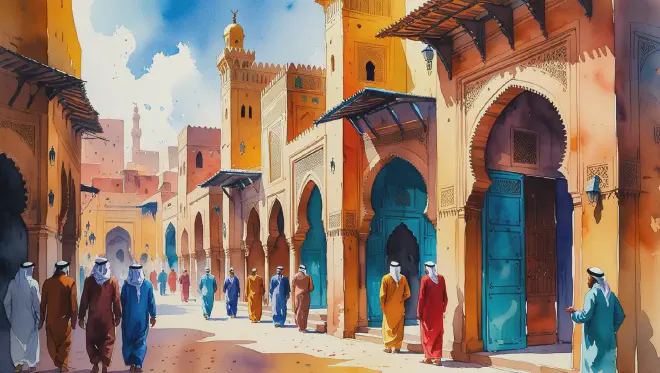Introduction: Time Spent Close to the Prophet’s City
Medina—officially known as Madinah al-Nabawiyah (City of the Prophet)—stands as Islam’s second holiest city and serves as a spiritual sanctuary for Muslims worldwide. Located in the central Hejaz region of western Saudi Arabia, this city presents a unique landscape where red desert sands meet green oases in harmonious contrast.
As the destination of Prophet Muhammad’s historic migration (Hijra) from Mecca in 622 CE, Medina holds profound significance in Islamic history. The city, which developed around the Prophet’s Mosque, continues to fulfill its role as a center of faith while simultaneously serving as a modern urban area home to approximately 1.5 million residents.
The opening of the Haramain High-Speed Railway has made travel between Mecca and Medina more convenient, attracting not only pilgrims but also visitors interested in Islamic culture. Here begins a journey to discover the unique charm of this city, where ancient date palm groves create oasis landscapes that harmoniously blend with modern architectural marvels adorned in beautiful white marble.

Day 1: Sacred Light and Arrival
I arrived at Prince Mohammad bin Abdulaziz International Airport as the desert sunrise began painting the horizon in golden hues. The view from the taxi window on the way to the city center was far greener than I had imagined, with date palm-lined avenues stretching into the distance. Abdullah, my driver, spoke fluent English and shared with me that “Medina is a land blessed by God’s grace.”
After checking into my hotel, I spent the morning at the Prophet’s Mosque (Masjid an-Nabawi). The massive white marble structure, crowned by a beautiful green dome that gleamed against the blue sky, commanded reverence. Knowing that Prophet Muhammad rests beneath this dome filled the surrounding silence with a special weight and meaning.
The mosque’s courtyard was quietly filled with pilgrims from around the world. The sight of people of various nationalities and ages, all facing the same direction in prayer, was truly awe-inspiring. The marble floor felt pleasantly cool beneath my feet, while enormous umbrellas provided shelter from the harsh desert sun for the worshippers below.
For lunch, I dined at “Al-Bayt Al-Hijazi,” an established restaurant near the mosque, where I savored traditional Hejazi cuisine. The “mandi”—a dish of lamb and basmati rice cooked together—offered a complex interplay of spices that dissolved gently on the tongue. Khalid, the restaurant owner, proudly told me, “This dish follows my grandmother’s recipe, unchanged for seventy years.”
In the afternoon, I explored the old city. Narrow alleys lined with ancient stone buildings housed small shops selling spices, aromatic woods, and handicrafts. Particularly memorable was a visit to an oud (agarwood) shop, where the owner burned some incense for me to experience. The scent was sweet and deep, reminiscent of a forest. “This is a fragrance for meditation,” he explained, and indeed, I felt my mind settling into calmness.
As evening approached, the beautiful call of the adhan (call to prayer) resonated throughout the entire city. The melodic recitation flowing from the mosque’s minarets, carried on the desert wind, penetrated deep into the soul. In that moment, I felt strongly the spiritual power that the city of Medina possesses.
That night, I sat on my hotel’s rooftop terrace, enjoying dates and Arabic coffee (qahwa) while gazing at the starry sky. Thanks to the clear desert air, the stars appeared close enough to touch. The distant sound of the night prayer’s adhan reminded me of the continuous cycle of faith that has persevered in this land for 1,400 years, and my first night quietly drew to a close with these contemplations.
Day 2: Oasis Traditions and Cultural Immersion
I woke early to coincide with the morning prayer time and experienced Fajr prayer at the mosque. Joining believers from around the world in prayer during the pre-dawn silence was a moving experience that transcended religious backgrounds. After prayer, breakfast in the courtyard was simple yet perfect: fresh dates, ful madammas (fava bean paste), and warm flatbread tasted exceptional in the pure morning air.
During the morning, I visited Quba Mosque, known as the first mosque built by Prophet Muhammad after his arrival in Medina. While the current structure has been beautifully restored, its historical significance remains unchanged. The white stone building harmonized with the surrounding date palms, enveloped in tranquility. Omar, a local guide, explained that “this is a special place for Muslims, and praying here on Saturday holds particular meaning.”
Before lunch, I stopped at the Medina Museum, where I learned about the history and culture of the Hejaz region. Particularly fascinating was the exhibition on ancient caravan routes, which clearly showed Medina’s importance as a crucial waypoint on the Silk Road. Ancient trading scales, pottery from various countries, and spice containers told the story of this land’s international history.
Lunch provided a precious opportunity—I was invited into a local family’s home. Abu Ali’s family participates in the city’s initiative to promote interaction between tourists and local residents. The “kabsa” prepared by his wife Fatima—a rice dish with chicken and spices—had a recipe that varied slightly from family to family, she explained. During the meal, I learned much about life in Medina. Particularly memorable was their observation that “living in Medina is like being on pilgrimage every day.”
In the afternoon, I planned a small excursion to Mount Uhud, located southwest of the city. This mountain, which was also an important battlefield during the Prophet’s time, is now maintained as a nature reserve. A hiking trail from the mountain’s base to its summit takes about an hour, and the views of desert and oasis along the way were breathtakingly beautiful. The contrast between red rock faces and green date palms is unique to this region.
From the summit, the city of Medina spread out below. I could see the green dome of the Prophet’s Mosque at the center of white buildings, surrounded by modern high-rises. This landscape, where ancient and modern coexist, truly represents present-day Medina.
In the evening, I participated in a traditional craft workshop. Under the guidance of Ahmad, a local artisan, I tried my hand at Arabic calligraphy. Drawing the beautiful curves of Arabic script proved more challenging than expected, from brush technique to character balance—everything was a fresh discovery. “Arabic calligraphy is like meditation,” Ahmad explained, and indeed, I felt my mind quieting as I wrote the characters.
That night, I enjoyed conversations with locals at a café in the old city. Gathered around water pipes (shisha), I spoke with pilgrims from various countries and local young people. Despite language barriers, smiles and gestures were sufficient for communication. As the night deepened, conversations turned to family, dreams, and faith, and I experienced connections between people that transcended nationality and culture.
Day 3: Farewell and New Beginnings
My final morning began with another visit to the Prophet’s Mosque. While reluctant to bid farewell to Medina after three days, I spent quiet time in prayer. This time served not merely as the end of sightseeing, but as a precious opportunity to confront my inner self. In the mosque’s silence, I was able to remember the spiritual peace often forgotten in daily life.
During the morning, I revisited the traditional market (souq) for final shopping. The aromatic wood shop owner I had met the previous day specially blended some incense for me to purchase. “This is for you to burn at home as a memory of Medina,” he said, and the small bag of aromatic wood became my most treasured souvenir. I also bought local dates, hand-woven carpets, and silver jewelry, each item filled with memories of conversations with shopkeepers.
For lunch, I returned to the restaurant I had visited on my first day. Khalid, the owner, remembered me and recommended, “Today, please try the maqluba.” This Palestinian dish, with vegetables and meat layered and cooked, is characteristically flipped over for serving at the table. The flavor was complex yet harmonious, making me appreciate anew the depth of Middle Eastern cuisine.
After the meal, I had a longer conversation with Khalid. He had immigrated to Medina from Lebanon thirty years ago and told me he was “attracted by this city’s capacity for embracing others.” His words that “Medina is a place that accepts people from around the world while simultaneously giving them peace” perfectly captured what I had felt during these three days.
In the afternoon, I visited a Medina date palm farm. I was able to observe the cultivation of Ajwa dates, Medina’s specialty. Saad, the farm owner, explained, “These date palm trees have been protected by my family for generations.” Seeing the sweet, rich fruit growing from ancient trees over 100 years old made me reflect on the value of things nurtured over time.
While enjoying freshly picked dates, I spent the afternoon under the shade of date palms. In the harsh desert sun, the coolness of the shade was exceptional. The city buildings visible in the distance, nearby red dunes, and the blue sky spreading overhead created a contrast that embodied Medina’s natural beauty.
Before departing on my evening flight, I walked through the old city one final time. The feeling was completely different from when I first set foot there three days earlier—now there was familiarity. I exchanged greetings with passersby, and several remembered me. Though my stay was brief, I truly felt a connection with this city.
In the taxi to the airport, Abdullah told me, “Please come back again.” The view of Medina’s cityscape in the evening light from the car window no longer seemed like an unknown place, but rather like “another hometown” that I was temporarily leaving.
Final Reflections: What Felt Real Despite Being Imaginary
Though this journey took place entirely in imagination, it remains in my heart as genuine memory. The unique charm of Medina—the harmony between deep history and modernity, the fusion of diverse cultures, and above all, the warmth of its people—feels as vivid as if actually experienced.
The silence of the Prophet’s Mosque, the vitality of the old city, the green shade of date palm farms, the view from Mount Uhud, and conversations with the people I met. All of these transcended mere imagination to become etched deep in my heart. Particularly profound was the human connection I felt across religious and cultural differences.
The fragrance of aromatic wood, the sweetness of dates, the brush strokes of Arabic calligraphy, the touch of desert wind. Everything felt through the five senses made this fictional journey real. Most importantly, the embracing capacity and peace that Medina possesses has become a source of comfort even after returning to daily life.
The end of a journey is also a new beginning. The experiences and emotions gained from this imaginary journey have strengthened my longing for actual travel and deepened my understanding of different cultures. I feel I truly understand how Medina can serve as a spiritual homeland for people around the world.
Despite being imaginary, the landscapes and encounters with people were undeniably present. This serves as proof of imagination’s power and teaches us about the true richness that the human heart seeks.

